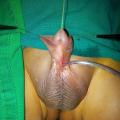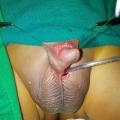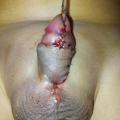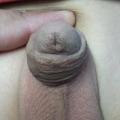You are here
Hypospadias
Hypospadias is a congenital abnormality of the penis in boys. It is common, occuring in 1 out of 150 - 200 boys (approx). The 3 main abnormalities in hypospadias are
1)the abnormal position of urinary meatus (opening) on the undersurface of the penis
2)abnormal bend (curvature) of the penis (called Chordee)
3)abnormal foreskin distribution on the penis (usually only half of the penis has foreskin in children with hypospadias).
In most boys, hypospadias is an isolated problem & all the child requires is a good surgery to correct the defect. In most (80-85%) cases, a single operation is sufficient to correct hypospadias with excellent results. Dr Sekharam has done over 500 hypospadias repairs. He has over 90% success with single-stage correction of most of hypospadias (including moderate to severe hypospadias with chordee). Dr Sekharam has published his results in reputed journals which can be accessed online. (please see below)
About 10-15 % of hypospadias are of the very severe type, usually associated with a small penis, bifid scrotum (scrotum spilt into two halves in the midline) & scrotal transposition (scrotum overriding the penis) where it may be difficult to estimate the sex of the child at first look. Such children require chromosomal tests (karyotyping) & other tests before planning surgical correction. Most such cases require 2 operations to correct the hypospadias (2-stage repair), but good final results can be expected in most cases in expert hands.
One testimonial given by a patient's father is given in this page
You can visit testimonials page to read more parents' responses to Dr Chandrasekharam's hypospadias surgery
Timing of surgery ?
The ideal age for hypospadias surgery is 6-18 months. This is based on various factors like the developmental, emotional & psychologic aspects of genital surgery in children. The idea is to repair it before the child bacomes aware of the defect that he has. The results in younger children have been shown to be better than older children. Moreover, it is much easier for the parents to manage small babies after surgery with the dressing & catheter (tube to drain urine). However, it does not mean that the operation should not be done in older boys.
What is done at surgery ?
Hypospadias repair (even what looks as a minor problem to the parents) is a complex operation. Unless performed by experts in the field, the risk of complications & failure is very high.
There are 3 essential steps of hypospadias surgery: Straightening the penis, creation of urethra (tube that transmits urine outside) till the tip of the penis & achieving good skin cover to the penis.
In primary hypospadias repair (first time surgery), the foreskin is utilized in the reconstruction, so that the final appearence after surgery is that of a normal circumcised penis.
Failure of hypospadias surgery is a major problem, & seeing a child with multiple failed operations is not uncommon. If the child had failed hypospadias repair (s) before, foreskin may not be available for reconstruction. In such redo cases, tissues such as buccal mucosa (delicate skin lining the inside of the mouth) may need to be used for reconstruction.
Dr Sekharam gets a lot of referrals both from within & outside Hyderabad for failed hypospadias repairs (sometimes after 4-5 failed operations elsewhere). He has excellent results even with these complex reconstructions.
Illustrative Hypospadias cases
Case 1: penoscrotal hypospadias with chordee


severe hypospadias with chordee
Good result after surgery, looks mostly like normal circumcised penis (Immediate & after 1 year)


Case 2 : Redo hypospadias Repair
5 year old boy operated for distal hypospadias elsewhere, repair failed & had a large fistula thru which urine was passing. The tissues were all scarred because of previous operation. The child underwent single stage redo hypospadias repair with excellent result. 1 month after the surgery, the child is doing well, with good stream of urine from the tip & the penis looking like a normal circumcised penis



Case 3: Redo Hypospadias Repair with Buccal Mucosal graft
3-year old boy with midpenile hypospadias operated in a neighbouring state. The entire repair fell apart & the penis was scarred, with skin hanging from one side of the penis. He was reoperated by us. A single-stage redo repair using buccal mucosal (delicate inner lining of the lip or cheek) inlay graft was done. The child was discharged after 2 days with the catheter which was removed after 2 weeks. The child did very well, is passing urine in a single good stream from the tip & the parents are extremely happy.







The above photos show the series of steps in the repair of this difficult redo hypospadias repair
Publications (Scientific papers published by Dr Sekharam on Hypospadias in various Journals)
3. Re: tubularized incised plate Urethroplasty with dorsal inlay graft preevnts meatal/neourethral stenosis: a single surgeon's experience. Journal of Pediatric Surgery 2012